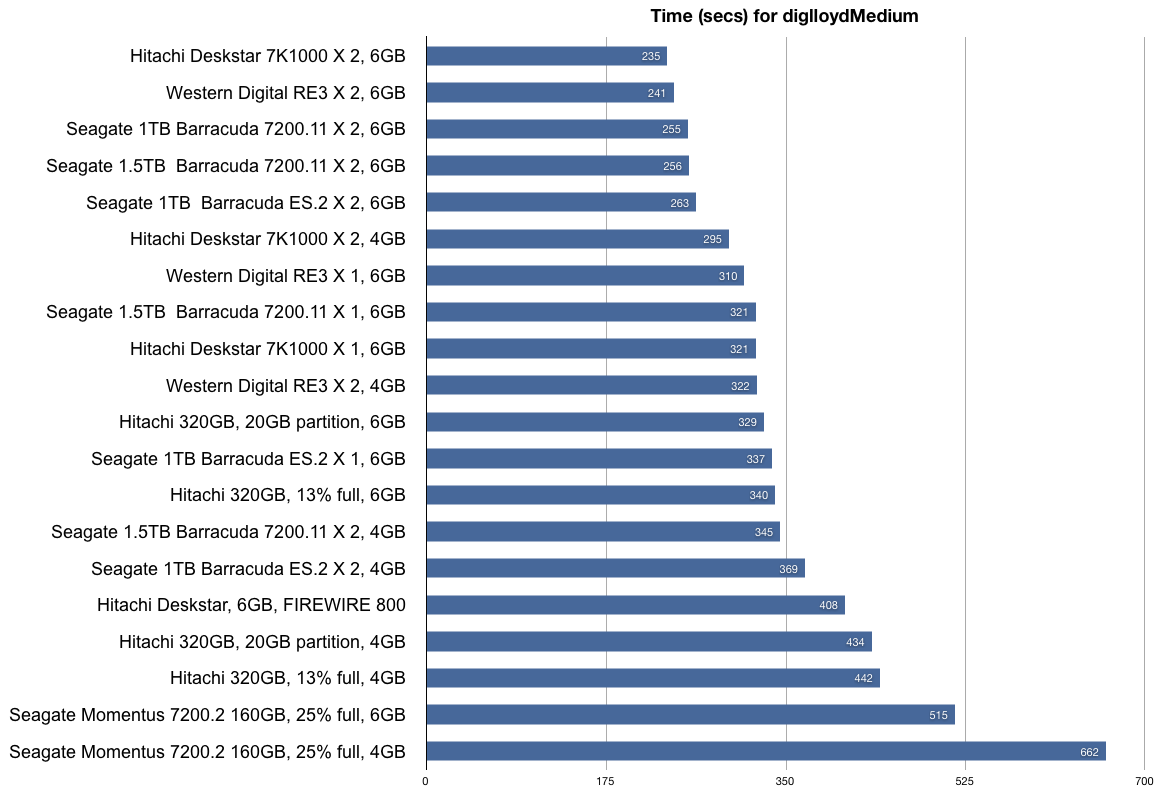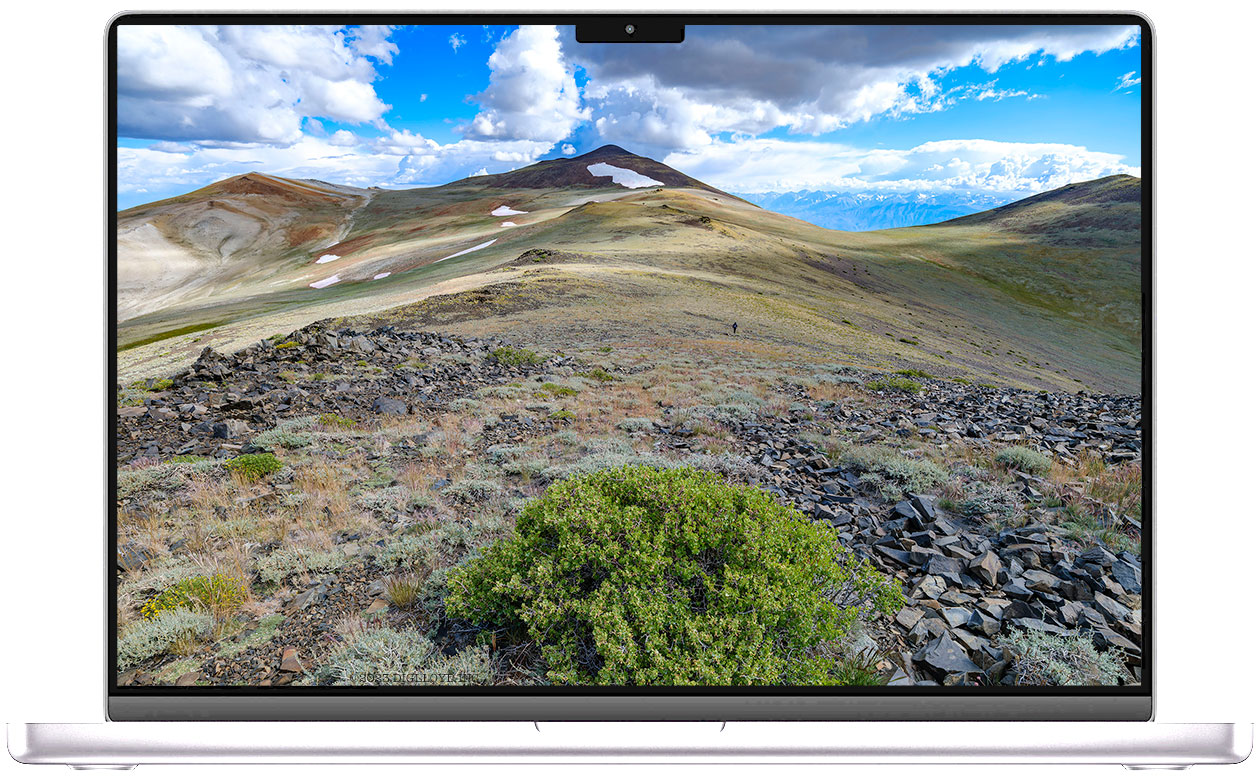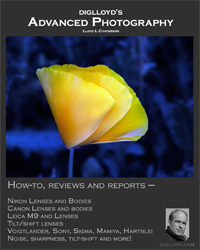
|

|

|

|

|
Test results for Photoshop CS4 on MacBook Pro
Related: eSATA, Expose Somewhat To Right, Expose To The Right, hard drive, laptop, Mac Pro, MacBook, MacBook Pro, memory, optimization, Other World Computing, Photoshop, Seagate, software
This page shows test results for the MacBook Pro. See also the Mac Pro results.
As with the Mac Pro, it is critical to install both the BiggerTiles and NoScratchCompression plugins. Failure to do so results in a time penalty of up to 40%. See the Configuring Photoshop page.
For MacBook Pro testing, only the diglloydMedium benchmark was used (20,000 pixel-wide image, 15.7GB scratch file), because diglloydHuge simply takes too long, and is therefore unrealistic for that kind of work. See the Benchmark Actions page for general info on how the tests were performed.
No more 4GB limit!
The MacBook Pro has long been limited to 4GB of memory. But an exciting new development (Nov 2008) now allows 6GB memory, which has significant impact on Photoshop performance for large files. See the review of the OWC 4GB memory module for the MacBook Pro for background.
If you already have 4GB in your 15" MacBook Pro, you can purchase a 4GB module, replacing one of your existing 2GB modules (sell it or give it away, it’s worth little). There is also a full 6GB kit, in case you’re starting from 2 X 1GB or 2 X 512MB configuration.
The 2009 MacBook Pro 17" accepts two 4GB modules for a total of 8GB, and this “rocks”, dropping test times by about 34%!
Why does 6GB vs 4GB matter so much?
An extra 2GB (6GB instead of 4GB) results in more usable system memory. After system boot, the free memory is approximately 5.3GB vs 3.3GB for the 6/4GB configurations. That’s 60% more. However, Mac OS X tends to “hold back” 200MB or so from caching. So the actual difference in usable memory for caching is closer to 5.1GB vs 3.1GB or 65% more.
The same principle applies to 8GB memory.
Results for diglloydMedium PERMALINK
For eSATA, this test used the FirmTek SeriTek/2SM2-E Express Card and the FirmTek SeriTek/2EN2 two-bay SATA enclosure (see Recommended Hardware for details). Two internal drive variants and one Firewire 800 configuration are also included.

Except for Firewire, all external drives used FirmTek SeriTek eSATA products
These results are with Mac OS X 10.5.5; 10.5.6 may be faster with eSATA
Update March 8, 2009 Go Faster! PERMALINK
The 2009 MacBook Pro 17" (see review) accepts 8GB of memory, which results in a 34% drop in execution time from 237 to 156 seconds (as compared with 4GB). The tests results below are with the Sonnet Tempo SATA Pro and FirmTek/Seritek/2EN2 with two Hitachi Deskstar E7K1000.E Saturn 1TB hard drives in a striped RAID.
8GB: 156 seconds
6GB: 185 seconds = 18% longer
4GB: 237 seconds = 52% longer
The Hitachi Saturn E7K1000 1TB drives are excellent performers. The Western Digital RE-3 1TB drives came in at 161 seconds.
Anyone working with large Photoshop files should invest in at least 6GB memory, 8GB being preferable, as well as a fast scratch volume.
Update Dec 11 2008 PERMALINK
The new (Dec 2008) Sonnet Tempo SATA Pro ExpressCard for the MacBook Pro offers significantly faster performance than the FirmTek SeriTek/2EN2 tested above: up to 200MB/sec for the Sonnet card vs 140MB/sec for the SeriTek Details. This translates directly into improved Photoshop speed on .
Here are some results with the MacBook Pro 6GB configuration, each of these is a 2-drive stripe, same as with the results graphed above:
Hitachi Deskstar 7K100: 220 = 7% faster
Western Digital: 221 = 9% faster
Seagate NS: 251 = 5% faster
Seagate 1.5TB: 231 = 11% faster
The Sonnet Tempo SATA Pro ExpressCard is more expensive than the FirmTek SeriTek card, and uses an improved chipset to gain it higher performance. If you use eSATA with your MacBook Pro, it’s now the way to go for maximum performance. See the Recommended Hardware page for more.
Interpreting the results
Good news: an optimized MacBook Pro (eSATA dual-drive + 6GB memory) can be configured to run about twice as fast as Apple’s best configuration from the Apple Store (4GB + 7200rpm internal). Compare that to the meaningless difference between Apple’s 2.4 and 2.5GHz MacBook Pro models.
To tease out the relationship between hard drive speed and memory, a variety of combinations were run as shown above. The results are consistent and clear:
- Hard drive speed: a 4GB system with dual eSATA can outperform a 6GB system without eSATA.
- Memory: 6GB offers a 30-40% performance enhancement over 4GB.
- A dual-drive eSATA scratch disk offers about a 40% performance gain over the fastest possible internal drive partition. (If the internal drive is not partitioned, speed will drop dramatically as the drive fills up).
- An internal hard drive fast partition is within 6% of the fastest single eSATA drive. But this partition might be problematic for BootCamp users.
- Firewire 800 cuts performance by about 27% versus eSATA (difference likely greater for dual drives, but not tested). Prefer eSATA over Firewire 800. Compare.
A very interesting point emerges: maximizing hard disk speed helps even more than upgrading from 4GB to 6GB of memory, nearly cutting the time in half over the stock internal drive. This is likely due to the fact that the scratch file for the test is 15.7GB—the disk I/O time still dominates the overall task. For smaller files, memory is likely to matter more.
Surprisingly, the best-performing 2-drive stripe was the Hitachi Deskstar, different from the Mac Pro results. These drives could be seen to make the last stages of the benchmark really fly—something about their behavior worked particularly well for the benchmark test.
The Western Digital RE 3 (best performer on the Mac Pro) is not far behind, and is slightly faster as a single drive. The Seagate Barracuda offerings are not the best choice for this scenario, showing notably slower results, and surprisingly, the top-end Barracuda ES.2 enterprise-grade drive performed the poorest of the 3 Seagate models!
Such are the vagaries of RAID and differing hardware, and sometimes workloads just match up well to specific drive characteristics (or match up not so well). This is why testing your own particular scenario is always best.
Even a single fast external SATA drive is a huge improvement over the stock 7200rpm internal hard drive. While current model notebook drives are likely faster than the tested internal drive, none of them are likely to match the current fast 1TB drives; for serious efficiency, an external SATA two-drive stripe is a requirement, albeit an inconvenient one.
Only
16GB / 512GB SSD
.
Great all-arounder at the right price
New and used Macs...
Upgrading the internal drive
My 2007 MacBook Pro initially used a 7200rpm hard drive (Seagate 160GB ST9160823AS). When tested about 25% full (with system and applications), its test results are uninspiring.
I replaced it with a brand-new (late 2008) Hitachi 320GB Travelstar HTS723232L9A360. Partitioning the drive to include a 20GB scratch partition, times dropped from 515 to 329 seconds, meaning that the original was taking 56% longer. With it serving as the boot drive and 13% full, time was 340 seconds, a smidgen slower.
Discussion
BootCamp issue with partitioning boot drive
If the internal drive is partitioned to allow for a fast scratch disk, Apple’s BootCamp Assistant refuses to allow the drive to be partitioned for use with BootCamp. However, one reader reports that using BootCamp to first partition the drive into the Mac and Windows partitions, then later using Disk Utility to partition the Mac partition into two partitions will work (not tested).
Asecond bootable system could be installed on a separate external drive, BootCamp run, Windows installed, etc and then Windows could be booted from the resulting partition.
Given these complications, partitioning is likely not a solution for many users.
MacBook Pro as a substitute for a Mac Pro?
When CPU speed alone is the main issue, a MacBook Pro at 2.83GHz should offer reasonably close performance on many operations to a MacPro at 2.8GHz or 3GHz. That’s because Photoshop rarely uses more than 2 CPU cores in total.
However, the MacBook Pro is no substitute for a Mac Pro when working with very large files. An optimized 3.0GHz Mac Pro desktop can handle diglloydHuge in about the same time an optimized 2.4 GHz MacBook Pro can handle diglloydMedium: that’s a 4X difference in workload (40,000 vs 20,000 pixels).
Consider also the disk I/O time alone opening a 1GB file: for an uncompressed TIF, this can happen in 3-4 seconds on a Mac Pro (4-drive stripe), but isn’t likely to happen in less than 10 seconds on a MacBook Pro, even with a 2-drive eSATA solution.
However, given the single-threaded and CPU-bound nature of opening and saving PSD and compressed TIF files (not uncompressed ones), the actual difference between a MacBook Pro and Mac Pro may be much smaller than one might expect, at least for a 2.83GHz MacBook Pro with 6GB memory and with smaller file sizes.
Downsides of external SATA
A 2-drive external SATA case is inconvenient for those on the go, though it’s perfectly fine for those in a desktop situation. However, the two scenarios are not exclusive; the fast eSATA solution can be used when “docked” at home or the office, etc.
Solution: go with the eSATA solution for performance, being prepared to leave it behind when “on the road”. If you’re always on the road, then be sure to install 6GB memory and the fastest internal 7200rpm hard drive available.
Suggested upgrades
See also the Conclusions page.
With the MacBook Pro there is a convenience factor to weigh as well as performance. While a dual-drive external eSATA solution offers the best possible drive performance, it is inconvenient for those on the go. Combining the actual measured performance improvements with the convenience factor, the following approach is suggested:
- Invest in the 6GB memory upgrade; benefits accrue to overall system responsiveness and all programs, not just Photoshop;
- Replace the internal hard drive if it’s not a 2008-vintage 7200rpm model. Be sure that the replacement has a 32MB onboard drive cache, such as the tested Hitachi 320GB model. If BootCamp is not a consideration, be sure to carve off a scratch partition; otherwise as the drive fills up performance will degrade substantially as the scratch file is forced to slower and slower parts of the drive.
- After steps above, add a dual-drive eSATA solution.
Appendix A — Table of data
The raw data is shown below, refer to the graph above. In most cases, at least two trials were run. Percentages refer to how much longer relative to the fastest setup.
| With 6GB memory | ||
|---|---|---|
| Drive(s) | Time (sec) | Comments |
| Hitachi Deskstar 7K1000 X 2 eSATA |
235 {236, 239, 232, 232} |
+0% |
| Western Digital RE3 X 2 eSATA |
241 {244, 238, 243, 237} |
+2% |
| Seagate 1TB Barracuda 7200.11 X 2 eSATA |
255 {263, 253, 249} |
+9% |
| Seagate 1.5TB Barracuda 7200.11 X 2 eSATA |
256 {255, 257} |
+9% |
| Seagate 1TB Barracuda ES.2 X 2 eSATA |
263 {259, 267} |
+12% |
| Western Digital RE3 eSATA |
310 {307, 312} |
+32% |
| Hitachi Deskstar 7K1000 eSATA |
321 {316, 326} |
+37% |
| Seagate 1.5TB Barracuda 7200.11 eSATA |
321 {319, 322} |
+35% |
Hitachi Travelstar 7K320, 20GB partition |
329 {332, 326} |
+40% |
| Seagate 1TB Barracuda ES.2 eSATA |
337 {341, 332} |
+43% |
Hitachi Travelstar 7K320, 13% full |
340 {339, 340} |
+45% |
| Hitachi Deskstar 7K1000 Firewire 800 |
408 {410, 406} |
+74% Firewire performance is mediocre |
Seagate Momentus 7200.2 160GB*** |
515 | +119% 25% full |
| With 4GB memory | ||
| 2 X Hitachi Deskstar 1TB eSATA |
295 {295, 295} |
Faster than single drive with 6GB! +26% |
| 2 X Western Digital RE3 1TB eSATA |
322 {324, 320} |
As fast as 6GB memory and a single drive! +37% |
| 2 X Seagate 1.5TB Barracuda 7200.11 eSATA |
345 {346, 344} |
+47% |
| 2 X Seagate 1TB Barracuda ES.2 eSATA |
369 {369, 369} |
+57% |
Hitachi Travelstar 7K320, 20GB partition |
434 {434} |
+84% |
| Hitachi Travelstar 7K320, 13% full internal |
442 | +88% |
Seagate Momentus 7200.2 160GB , 25% full*** |
662 | +182% |
*** The internal 7200rpm MacBook pro hard drive was approximately 25% full, so the scratch file could not reside on the fastest part of the disk.
Seagate Momentus 7200.2 160GB = ST9160823AS, Hitachi Travelstar 7K320 = HTS723232L9A360

 diglloydTools™
diglloydTools™


